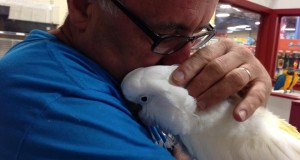
Once you acquire the reputation of being a skilled pet-keeper (or of having a soft heart!), springtime may bring with it requests from well-meaning folks that you care for “abandoned” animal babies they have found. In my long experience as a wildlife rehabilitator I have raised Flying Squirrels, Opossums, Raccoons, Muskrats and many other furry friends (the oddest being a Star-Nosed Mole!) – very rewarding work, but not to be taken on lightly.
Caution – Mom May Be Watching!
It is important to keep in mind that young mammals usually leave the nest long before they have learned to avoid danger – they appear to be clumsy and helpless, but their mother is usually nearby. Untrained persons should not approach such animals…even youngsters may bite, and rabies can be transmitted by any species. Especially to be avoided are those that seem “friendly”, and nocturnal animals (i.e. Opossums, Bats, Raccoons) that are abroad by day.
Female Raccoons, Foxes, Coyotes, Bears (please– stay away from Bear cubs!) and others often watch their young from a hidden retreat, and may attack people who approach. Common in many major cities, Raccoons are interesting creatures but cause serious problems (i.e. the transmission of a potentially deadly parasite in their feces) when they take up residence near people. It is best not to encourage them by providing food.
Getting Help and Advice
Animals that seem genuinely in need of assistance should be reported to your state wildlife agency or the police. The National Wildlife Rehabilitators Association can refer you to local experts. That organization, or your state wildlife agency, can also advise you on becoming a licensed wildlife rehabilitator.
Becoming a Wildlife Rehabilitator
Wildlife rehabilitators care for injured and orphaned wild animals with the goal of returning them to their natural habitats. Only in rare cases may un-releasable animals be retained by educational facilities. Some rehabilitators work with animals ranging from Chipmunks to Deer, while others specialize in activities such as rearing baby birds (an additional Federal permit is required to work with birds).
Nearly all rehabilitators function on a volunteer basis (and spend a good deal of their own money in the process!); most work at home, but association with a nature center or animal hospital is sometimes possible.
Please Note
Although extremely rewarding and interesting, wildlife rehabilitation is not without risks….zoonotic diseases and bites are a major concern. In the photos attached to this article I am handling animals that there rejected by their mothers and raised for use in zoo-based education programs.
Further Reading
Mammals are not the only animals that run into trouble at times…for information on working with other creatures, please see Helping Injured Amphibians and Reptiles
and Bird Rehabilitation.
 That Pet Blog That Pet Place Pet Blog
That Pet Blog That Pet Place Pet Blog



